Common House Spiders Found Around Homes
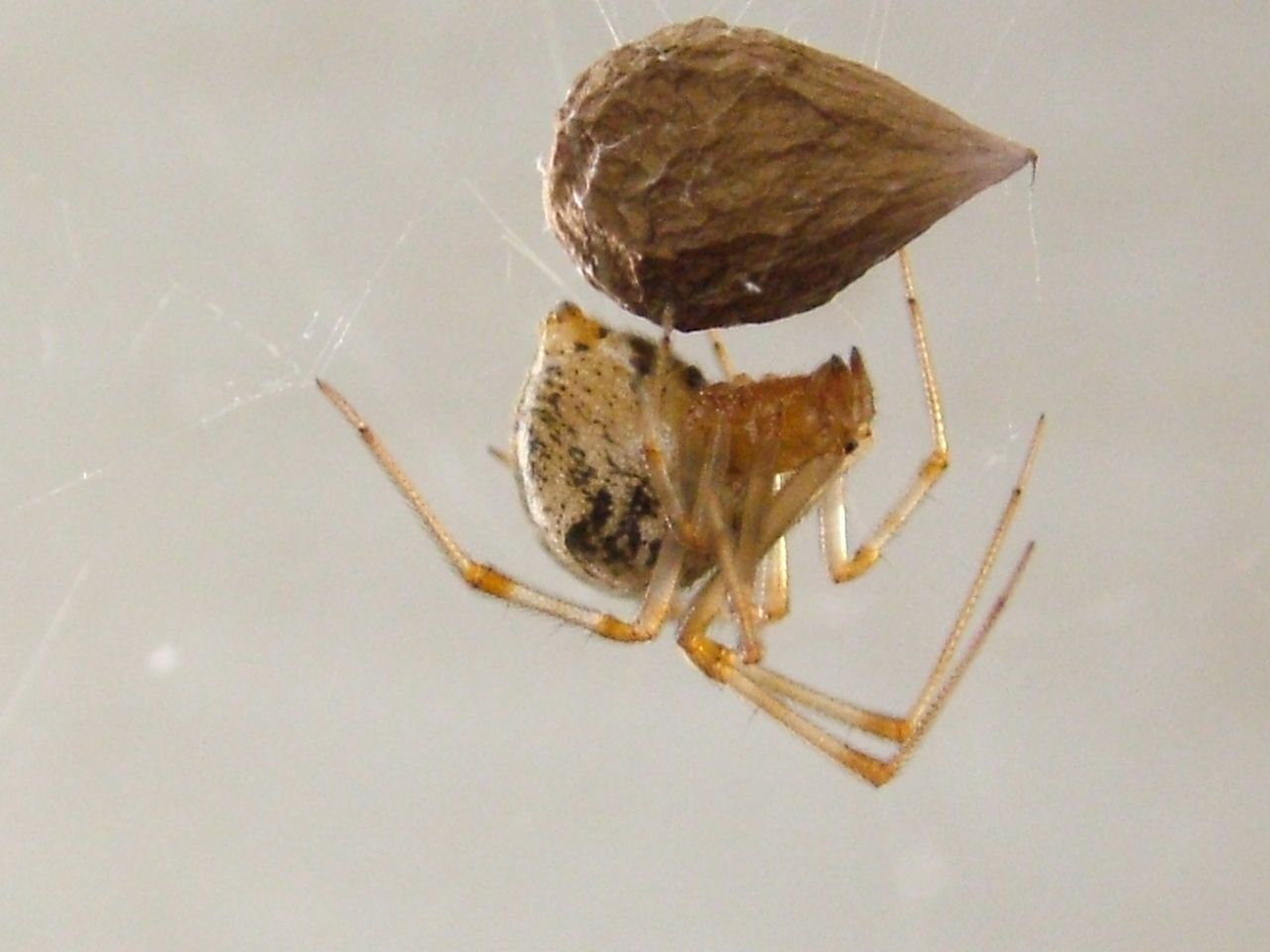
Common House Spiders Pictorial Guide (Eastern US)
If you're like my friends then the thought of finding a spider in your house causes an immediate visceral response, least of which would be putting on boots and grabbing the Raid can. I know I can't change most people's minds, but I can at least help you identify the spiders you might find and reassure you that they are (for the most part) harmless and quite beneficial. In today's post I'm going to give you a quick guide to the types of spiders commonly found in and around homes in the Eastern United States. These spiders are often referred to as "common house spiders" but the term "house spider" is a bit misleading, and how common they are depends on where you live and the environment in and around your home.

First, let's get this straight, 99% of spiders in your home and around your home are not dangerous to people. There are only two species you should be worried about, brown recluse and black widows, and even those are super shy.
When you start looking at common house spiders you'll notice that there are two main types, hunting spiders and web building spiders. Hunting spiders are the ones that run around on the ground for the most part (often scaring the bejeebus out of people), and web builders are just that, they build webs and sitting in them. For each spider below I'm going to give you three key bits of information:
- Web builder or hunting spider
- Where they might be found in your home
- Are they dangerous to you, your pets, or children?
SPIDERS THAT CAN BE FOUND INSIDE AND OUTSIDE THE HOME
American House Spider (Parasteatoda tepidariorum): (web building; found in corners inside and outside, high or low locations; not a threat to people)
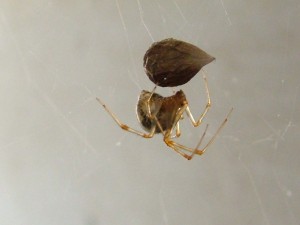
These are the most commonly found web building spiders in your home, they're brown and marbled and just hang out.
Cellar Spiders (Phoicidae sp): this is a large group of spiders that are often called "daddy long legs" but they are not harvestmen or the common daddy long legs, which really aren't spiders. Mostly this group is known for its long spindly legs. (web builders; found high and low in dark places; not a threat to humans).

They are the ones that creep people out because of their crazy long legs and Nosferatu feeling touch.
Barn Funnel Weaver Spider (Tengaria domestica): (funnel web building; found in low webs around grasses and in corners, usually ankle height or lower, sometimes hunts outside of web; not a threat to people)

These freak people out mostly because they are brown and fuzzy and get lumped in with "wolf spiders" even though they're harmless.
Black Widow Spider (Latrodectus sp.): (cobweb building; usually under objects, in dark and damp places such as wood piles, basements, behind book shelves, where there is little light; bite can be painful and cause distress).
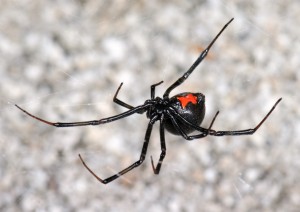
Cupboard Spider (Steatoda sp.) also called "False Black Widow Spider." (cobweb builder; found in corners inside and outside, high or low locations; bite can cause blistering and mild response)
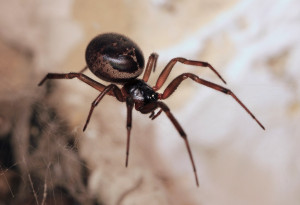
Admittedly these are intimidating, because they are dark brown or black and look like black widows, but they're not. They do have a bit of a bite, so best to avoid them.
Brown Recluse (Loxosceles reclusa) : (Hunting spider; usually on the ground, but can also climb into sheets, clothing, and shelving; bite can cause tissue necrosis and illness)
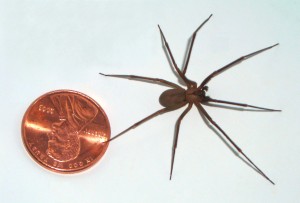
Brown recluse bites are more common than you think, though most don't result in tissue death. Sometimes they don't even inject venom, they just bite. These guys are the size of a penny and super hard to find. Mostly they're shy. Look for a violin shape on their back.
Bold Jumping Spider (Phidippus audax): (hunting spider; usually on ground and not above waist level; not a threat to people).

These guys are tiny but have BIG attitudes. They jump and move around like Mario..got to say, they're my all time favorites.
Wolf Spider (Lycosidae sp.): (hunting spider; usually found on the ground and hunting at night; not a threat to people but they can be fairly large)
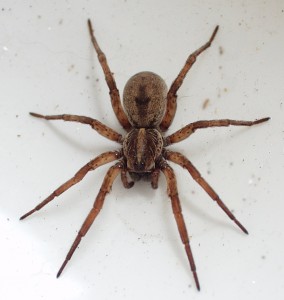
SPIDERS FOUND MOSTLY OUTSIDE THE HOME
Orchard Spider (Leucauge venusta): (web builder; usually found low, around gardens, plants, and even door frames; not a threat to people)
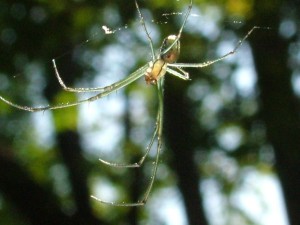
I love these spiders, they're brightly colored, iridescent green and shiny, but also tiny.
Garden Spider (Agriope aurantia) : (web builder; usually calf height or higher, around gardens and plants; not a threat to people but they do get big)

This is the classic garden spider that has a zig-zag in the middle of its web. They often get quite large but they are a boon to gardeners. Most people really don't appreciate how useful spiders are in the garden. They do a great job of helping to control other pests.
Grass Spider (Agelenopsis sp.) : (sheet/funnel web builder; usually ankle height and in grassy areas, sometimes comes inside in fall; not a threat to people)
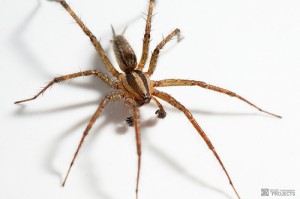
These are brown and stripy, but are small even as adults. They are often confused with wolf spiders.
Fishing Spider (Dolomedes sp.): (hunting spider; usually on ground in leaf litter and around ponds or bodies of water, though it can be found in houses; bite can be painful but not a threat to humans)
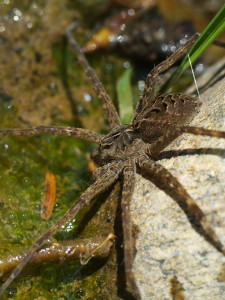
Ok, I have to admit that these suckers can get big, and scary. Some are palm size. They're harmless though, and really just enjoy fishing with their legs in the water. Don't confuse them with wolf spiders.(Can sometimes be recognized by silly hats decorated with fish hooks, bits of bait and other smelly accoutrements. Also often carry a cane pole and whistle as they head for fishing holes!)
In Conclusion....
Common house spiders are just that, "common" and helpful parts of our communities. By and large spiders are simply hanging out, looking to suck down a good insecty meal and leave you and yours alone. They aren't out to harass, chase, or torment you. So for the peace of all involved the best thing to do when you encounter them is to leave them alone or move them outside. You you can even use the "Critter Catcher" tool if you like.

Still not sure what spider you have? Try my other posts on spiders. Click on the side bar menu that says "spiders" and look for articles on brown spiders, orange spiders, and yellow and black spiders.

